Sat 11 Aug 2012
RICHARD DEMING’s Manville Moon series, by Jon L. Breen.
Posted by Steve under Authors , Bibliographies, Lists & Checklists , Characters[13] Comments
by Jon L. Breen
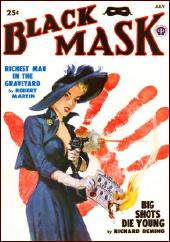
Richard Deming (1915-1983) was a solid and reliable pro whose crime-writing career extended from late 1940s pulps to early 1980s digests. He also wrote several volumes of popular non-fiction late in his life.
He is most likely to be remembered as one of the most prolific contributors to Manhunt and the early days of Alfred Hitchcock’s Mystery Magazine and as a paperback original writer, sometimes of novels based on TV shows (Dragnet, The Mod Squad, and under the pseudonym Max Franklin, Starsky and Hutch). He was also a frequent ghost for the Ellery Queen team on paperback originals and for Brett Halliday on lead novelettes for Mike Shayne Mystery Magazine.
The private-eye hero of Deming’s earliest pulp stories and a number of his Manhunt stories was Manville Moon, who lost a leg in World War II, a disability that slows him down occasionally but not much.
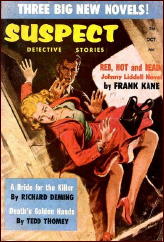
The four full-length novels about Moon, all reissued as ebooks by Prologue Books and available at Amazon in the three-to-four dollar range, are notable for their uncharacteristic (for Deming) hard covers and (with one exception) their evocative titles. They reveal Deming to be, in common with Rex Stout, George Harmon Coxe, Erle Stanley Gardner, and quite a few others, a writer who drew on both classical and hardboiled conventions.
In The Gallows in My Garden (1952), Moon tells his story in smooth, relaxed, somewhat Goodwinesque first person. The terrific title comes from G.K. Chesterton’s “A Ballade of Suicide.†The setting is an unnamed Midwestern city, and the author exhibits a comfortable postwar Midwestern sensibility. The book is dedicated as follows: “To my mother, who would prefer me to write innocuous tales about members of Dover Place Church.â€
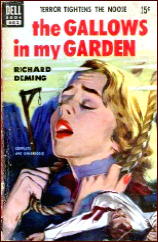
Though he will go through all the tough-guy paces, Moon is not really such a hardass and certainly a gentleman in his dealings with women. There’s some good character drawing but the secondary regulars (girlfriend Fausta Moreni, an Italian war refugee turned restaurateur; annoying comic sidekick Mouldy Green, a Moon Army buddy; and irascible friendly enemy cop Warren Day) seem made for radio.
The case is a classical whodunit setup, focused on an inheritance. Moon’s client, a 19-year-old heiress who will not collect her massive fortune until her twenty-first birthday, tells him a series of seemingly accidental close calls have convinced her someone is trying to kill her.
But it is her brother who becomes a murder victim. Many will share my immediate suspicion that Deming had lifted the plot and its ultimate solution from a very famous Golden-Age detective novel, and even those who do not know the novel in question might see that solution coming.
Does Deming have a surprise in store? Moon conducts a gathering of the suspects to reveal the generously-clued killer. The devotion to fair play puzzle spinning continues in all four novels, but this first is much the best of them.
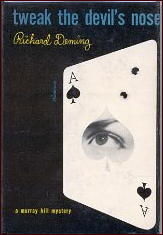
Tweak the Devil’s Nose (1953) begins with the shooting of the lieutenant governor of Illinois outside El Patio, Fausta Moreni’s nightclub and restaurant. Fausta is rich, which is a problem for Manny, a situation similar to those in many of William Campbell Gault’s novels. More of the obligatory gangsters and fight scenes are there to pay Deming’s hardboiled dues. It’s highly readable and entertaining, though not as good as its predecessor.
Give the Girl a Gun was originally published as Whistle Past the Graveyard (1954), a much better title, though the new one at least fits the story. Central to the plot is a new invention designed to prevent hunters from accidentally shooting each other. Deming inserts fisticuffs and a standard girlfriend in danger suspense sequence not vital to the main plot before another gathering of the suspects clears things up.
Juvenile Delinquent, published in Great Britain in 1958, apparently never appeared as a complete novel in the United States prior to the Prologue ebook, though it was published in Manhunt (July 1955) in a shorter version.
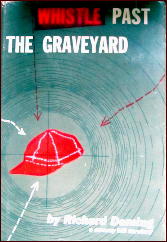
It lacks the light touch of earlier books in the series, offering a serious look at the J.D. problem with much preachment and speechifying included. It has a kind of procedural feel early on, reflecting a change of style and fashion in the middle fifties. The serious intent may be admirable, and I would never go so far as to miss the comic relief, but the didacticism makes this generally less successful purely as entertainment.
Fausta and the utterly unbelievable Mouldy finally appear in the second half, but the change to a lighter tone doesn’t help much. The cop contact is present but more subdued. The mystery plot is on the thin side, though the solution is typically well worked out.
In sum, Deming is a consistently reliable performer, always readable and entertaining. And admirers of the classical puzzle might see through the fisticuffs to a refreshing adeptness at misdirection.
The Manville Moon series —
The Gallows in My Garden. Rinehart & Co., hardcover, 1952. Dell #682, paperback, 1963.
Tweak the Devil’s Nose. Rinehart & Co., hardcover, 1953. Jonathan Press J-91, paperback, as Hand-Picked to Die, 1956 (abridged).
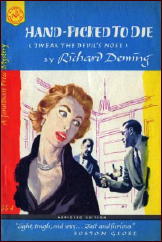
Whistle Past the Graveyard. Rinehart & Co., hardcover, 1954. Jonathan Press J-83, paperback, as Give the Girl a Gun, 1955 (abridged).
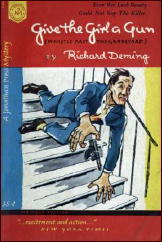
Juvenile Delinquent. Boardman, UK, hardcover, 1958. (No US print edition.)
August 11th, 2012 at 8:38 pm
Thanks, Jon for the informative primer on Richard Deming. When Prologue had a sale on these and others I bought one or so of each author. For Deming, I picked GIVE THE GIRL A GUN because of the title, but had little clue to what I was buying.
It is amazing how few informative reviews of these out of print authors books returning as ebooks are available on the web. Usually, its some bookseller more interested in the book’s condition than content.
Even the publishers such as Prologue seem to assume we are familiar with the contents. It is hard to get an idea whether I am buying a Norbert Davis or a David Goodis. The small press is great at promoting and giving background of the author, but we need more reviews such as this one that informs us of what kind of PI story we are getting.
August 12th, 2012 at 11:42 am
I’d like to thank Jon too, for sending me this piece, and for many of the same reasons that Michael says. Reviews of individual books in a series can always be helpful to a would-be reader, but overviews of the entire series like this are even more valuable.
And of course much more difficult to put together.
What also caught my eye, Jon, was your last sentence: “And admirers of the classical puzzle might see through the fisticuffs to a refreshing adeptness at misdirection.”
I’ve always had the idea that such a statement might apply to many hardboiled writers in the late 1940s through the 50s, and in some cases later.
That was the time that the Golden Age of Detection was winding its way down and tastes in mystery fiction were changing. But even as authors of PI stories were writing harder-edged novels, they also seemed to feel that readers were expecting a puzzle story as well, with clues, interrogation of witnesses and a twist or two in the plot designed to sneak up on the reader and knock his socks off.
Figuratively speaking, of course.
Authors like Deming, but others too, like William Campbell Gault (Joe Puma, Brock Callahan), Henry Kane (Peter Chambers), Frank Kane (Johnny Liddell), Thomas B. Dewey (Pete Schofield, Mac), Richard Ellington (Steve Drake) and many others I’m not thinking of now. Not big names now, but they all sold a lot of books back then, especially in paperback.
Someday when I have the time, I’d like to work some more on this theory. At the moment, though, it’s good to see Jon’s reinforcement of the idea, at least in Deming’s work.
August 12th, 2012 at 12:35 pm
Jon is skilled at the critic’s buzz words, those delightful word or phrase that enlightens one regarding the work. As one who seeks light mysteries such as Norbert Davis, the words “annoying comic sidekick” told me all I needed to know about the books.
August 12th, 2012 at 1:54 pm
Which is exactly what a good critic/reviewer is supposed to do: tell you all you need to know about a book, even if it’s to steer you away from it.
Back when I read the first three Manny Moon books — I only learned about the fourth one from Jon’s review — comic sidekicks didn’t bother me all that much. I grew up watching 1940 B-westerns, after all. In fact, I don’t even remember Mouldy Green, which is surprising. After all, who would name their kid Mouldy Green?
August 14th, 2012 at 4:18 pm
Deming wrote a couple good books: BODY FOR SALE and HIT AND RUN; I’m afraid most of the rest is somewhere South of Contempt.
August 14th, 2012 at 4:57 pm
Over the years, Deming never did hit the big markets. Paperback originals, TV tie-ins, and ghost-written books, that’s about all.
To me, other than the Manville books, none of the rest of his resume stands out as anything exceptional. I don’t remember reading anything by him that I haven’t enjoyed, but you might be right about BODY FOR SALE (1962) and HIT AND RUN (1960) being the best of the rest. I know I must have read them, but here it is 50 years later, and sad to say, I can’t say I did for sure.
August 27th, 2012 at 5:58 am
The Manny Moon books were just ok in my humble opinion, but I loved LOSERS WEEPERS (1966) written by Deming as by Ellery Queen, a non Queen Family title.
March 26th, 2013 at 2:00 pm
I found Gallows in the Garden to be the best of Deming’s novels and enjoyed most of his M. Moon novelets published in pulps/digests. He had at least 1 more good pbo novel…I believe it was Vice Cop..going by a fadeaway memory.
September 30th, 2014 at 11:24 pm
I’ll tell you what Deming delivered brilliantly — and I’m not kidding.
DRAGNET.
Three books written during the original run of the TV series: two novels for Pocket and a Whitman book of short stories (reissued in the 60s for the revival, with two or three fewer stories and Frank Smith’s name changed to Bill Gannon). In terms of tone, rhythm, pace, Deming had it nailed. He didn’t deliver it solemnly, but he did deliver it seriously with the “straight face” of a true believer.
Now, that said — and forgive me moving off-topic, but I can’t resist the free-association —Deming wasn’t *quite* as brilliant at DRAGNET as Richard Prather (who wrote the first of those three Pocket originals as David Knight). But that’s because Prather managed to add a subversiveness that wasn’t in Deming’s wheelhouse. Reading his entry (called CASE 561), it’s *very* clear he knows how over-the-top Jack Webb’s clipped style goes, but he just as clearly regards it with affection; so he walks the very fine line that separates stylistic self-awareness from parody. He never *crosses* that line, but you keep smiling because what he doesn’t hide is how much fun he’s having in the Joe Friday persona.
While I’m here, all the DRAGNET books but one are indeed narrated by Joe Friday — and that exception is DRAGNET 1968 (Popular Library), based on the revival, by David H. Vowell. I wrote the chapter on 60s and 70s TV tie-ins for the non-fiction anthology TIED-IN, about media-generated books, and if you’ll allow, I’ll just paste a DRAGNET-relevant paragraph from it here:
There’s reason to believe that an original Dragnet novel (based on the mid-late-60s revival) by free-lancer Robert Tralins, titled DRAGNET 1967, was briefly published by Popular Library and immediately pulled at the behest of series creator and star Jack Webb, who would seem to have disliked the book enough to exercise a contractual right of approval. (Tralins, still alive as of this writing, confirms that he indeed wrote the book, though he neglected to keep a copy of the manuscript; and there are those who claim to have seen or owned copies now completely lost to posterity and creative Googling.) Jack Webb’s intervention is assumed because the subsequent book, DRAGNET 1968—which was released successfully by the publisher and remained in print for the life of the revived series—was written by David H. Vowell, a then-active scriptwriter for the TV show who had never before authored a novel. If one assumes that Popular Library was still contractually entitled to a Dragnet tie-in, and demanding compensation for the title that was pulled, one can also extrapolate that Webb asked Vowell to take the assignment, and offered him to the publisher as an alternative. Which explains what is, even now, a rare example of a show scripter also authoring an original novel based on that show.
July 17th, 2017 at 1:35 pm
While the city in The Gallows in my Garden is never outright called by name it is clearly St. Louis, Missouri. There are several direct references to downtown St. Louis streets (a bar on 4th & Market and another place at Front & Locust). But the clincher is an entire chapter devoted to a taxi ride to the train station and a chase on a train just before it leaves. It all takes place at Union Station located on Market street, both places mentioned in the book several times. Finally, there is a remark about someone taking the ferry to Illinois. All of this makes the setting nowhere else but St Louis.
I’m getting ready to read the other two in the series and will be looking for more clues to verify this, but I’m pretty positive St Louis is the city for Manny Moon.
July 17th, 2017 at 7:11 pm
Thanks for this, John. I’ve sent you comment on to Al Hubin to see what he thinks, but I for one am persuaded.
July 18th, 2017 at 10:06 am
And so is Al. Let us know about others in the series, when you get to them.
August 29th, 2018 at 1:06 pm
I just bought a mod squad book he wrote. I hope it is goood